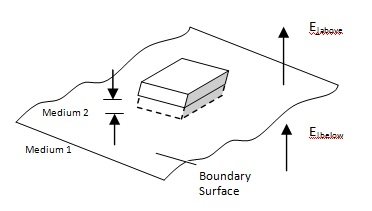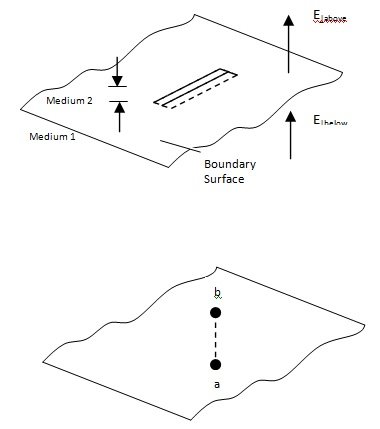Electrostatic Boundary Conditions
Electrostatic Boundary Conditions Assignment Help | Electrostatic Boundary Conditions Homework Help
Electrostatic Boundary Conditions
Let us examine how the electric field changes at the boundary between two different media. Let us fine amount by which E changes at such a boundary.
(A) Let us construct a small Gaussian pillbox, extending just barely over the edge in each direction. A is the area of the pillbox lid, h is the thickness of the pillbox. Applying Gauss’s law,
Φ E. da = 1/ε0 Qenc = 1/ε0 σA,
Now, the sides of the pillbox contribute nothing to the flux as h  O. So
E| above – E| below = 1/ε0 σ … (1)
Here, E|above denotes the component of E that is perpendicular to the surface immediately above, and E|above denotes the component of E that is perpendicular to the surface immediately above, and E|below is the same, only just below the surface. For consistency we let “upward” be the positive direction for both.
According to Eq. (1), the normal component of E is discontinuous by an amount σ/ε0 at any boundary.
If the boundary is free from charge, σ = 0, then E| is continuous, i.e., the normal component of E is continuous across a charge free boundary.
(B) Since the electrostatic field is conservative,
Φ E. dl = 0
around the rectangular path EFGH. The lengths EF and GH will be taken equal to 1 and the segments FG and HE will be assumed to be negligibly small (h 0). Therefore
or E||above l – E||below l) = 0
E||above = E||below … (2)
Here, E|| represents the components of E which is parallel to the surface. Thus the tangential electric field is continuous across such a boundary. The boundary conditions on E [Eqs. (1) and (2)] can be combined into a single formula:
Eabove – Ebelow = σ/ε0 n, … (3)
Here, n is a unit vector perpendicular to the surface.
(C) The electrostatic potential must be continuous across any boundary, since
Vabove - Vbelow = - ∫ba E.dl
As the path length shrinks to zero, so too does the integral.
. : Vabove = Vbelow … (4)
From Eq. (3),
∇Vabove - ∇Vbelow = - 1/ε0 σn (. : E = - ∇V)
Or, ∂ Vabove /∂n - ∂ Vbelow /∂n = - 1/ε0 σ … (5)
Here, ∂V /∂n = ∇V. n denotes the normal derivative of V.

For more help in Electrostatic Boundary Conditions please click the button below to submit your homework assignment